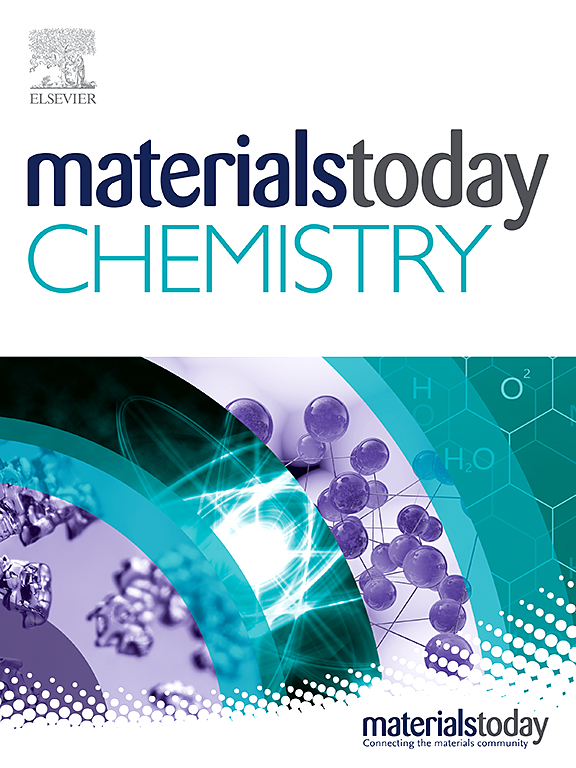在类似气凝胶的基底上构建聚苯胺:聚(苯乙烯磺酸)-碳多功能骨架,用于高性能凝胶电解质友好型纤维状中空多孔电极
IF 6.7
2区 化学
Q1 CHEMISTRY, MULTIDISCIPLINARY
引用次数: 0
摘要
为增强全固态纤维状电极的功能,应谨慎处理高负载质量和凝胶电解质的良好渗透问题。在这里,电纺丝甘油改性聚丙烯腈(PAN)纳米纤维(GPN)附着在钛丝上,作为多孔高负载质量纤维状气凝胶基底,并选择聚苯胺:聚(苯乙烯磺酸)-碳(PANI:PSS-碳)墨水作为活性材料分散体。PANI:PSS-carbon 很容易渗入 GPN@Ti 中,并通过浸涂和冷冻干燥相结合的工艺形成具有微孔结构的中空纤维状电极。得益于高负载伪电容材料和良好的凝胶电解质浸润通道,所制备的 PANI:PSS-carbon@GPN@Ti 电极在全固态纤维状超级电容器装置中显示出 553.9 mF cm(2637.6 mF cm)的高比长电容,优于之前报道的大多数纤维状电极。这些特点表明,在固态储能装置中使用 PANI:PSS-carbon@GPN@Ti 电极大有可为。此外,这种简单的策略为构建高性能凝胶电解质友好型柔性电子电极提供了新的视角。本文章由计算机程序翻译,如有差异,请以英文原文为准。
Building polyaniline:poly(styrenesulfonate)-carbon multifunctional skeleton on aerogel like substrate for high performance gel-electrolyte-friendly fiber-shaped hollow porous electrode
To enhance the functionality of all-solid-state fiber-shaped electrode, high mass loading and well infiltration of gel electrolytes should be carefully addressed. Here, electrospinning glycerol-modified polyacrylonitrile (PAN) nanofibers (GPN) are attached to Ti wire as porous high mass loading fiber shaped aerogel like substrate, and Polyaniline:poly(styrenesulfonate)-carbon (PANI:PSS-carbon) ink is selected as active materials dispersion. PANI:PSS-carbon easily infiltrates into GPN@Ti and supports a hollow fiber-shaped electrode with micropores structure through a combination of dip-coating and freeze-drying processes. Thank to high mass loading pseudo-capacitive materials and well infiltrate channel for gel-electrolyte, the resulted PANI:PSS-carbon@GPN@Ti electrode shows a high specific length capacitance of 553.9 mF cm (2637.6 mF cm) in an all-solid-state fiber-shaped supercapacitor device, outperforming the majority of previously reported fiber-shaped electrodes. These features suggest promising potential for utilizing PANI:PSS-carbon@GPN@Ti electrode in solid-state energy storage devices. In addition, this simple strategy gives a new view for constructing high performance gel-electrolyte-friendly flexible electronic electrode.
求助全文
通过发布文献求助,成功后即可免费获取论文全文。
去求助
来源期刊

Materials Today Chemistry
Multiple-
CiteScore
8.90
自引率
6.80%
发文量
596
审稿时长
33 days
期刊介绍:
Materials Today Chemistry is a multi-disciplinary journal dedicated to all facets of materials chemistry.
This field represents one of the fastest-growing areas of science, involving the application of chemistry-based techniques to the study of materials. It encompasses materials synthesis and behavior, as well as the intricate relationships between material structure and properties at the atomic and molecular scale. Materials Today Chemistry serves as a high-impact platform for discussing research that propels the field forward through groundbreaking discoveries and innovative techniques.
 求助内容:
求助内容: 应助结果提醒方式:
应助结果提醒方式:


